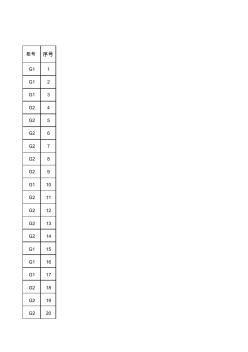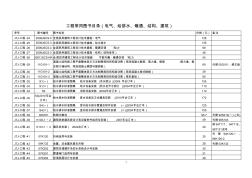智能计算与应用图书目录
Section 1: Evolutionary Computation
Application of 2D Entropic Segmentation Method Based on Particle Swarm Optimization Algorithm
A Hybrid Algorithm Based on Evolution Algorithm and Shooting Method for Solving the Interplanetary Transfer Orbit in Multibody System
Research of PSO Parameters Based on Multi-Task Scheduling Problem
Exploration of Shortest Path Problem Based on Genetic Algorithm
Study on Application of Improved Genetic Algorithm in Bus Dispatching
Optimization of LEO Regional Coverage Satellite Constellation Via IBEA Algorithm
Design of Placement Algorithm with Fault-Tolerance Based on Dynamic Evolvement Arithmetic for Coarse-Grain Reconfigurable Architecture
A Balancing Chemical Equation Approach with Evolution Strategy
Detection of Weak Signal Via Bistable Stochastic Resonance Combining with Genetic Algorithm
A Hybrid Genetic Algorithm for Well Placement Optimization
The Application of Improved Vector Evaluated Genetic Algorithm in Earth-Mars Orbit Optimization
Section 2: Evolutionary Multi-Objective and Dynamic Optimization
Optimization for Multi-Join Queries of Relation Database Based on Ant Colony Algorithm
The Optimized Path Tracking Control of Mobile Robots Based on Adaptive Sliding Mode
Application of Topology Optimization Techniques to Frame Design of One Electrical Tractor
An Improved Regularity Model-Based Multi-Objective Estimation of Distribution Algorithm
Implement Tree-Based Genetic Operators in GEP
Based on Air Quality Prediction Study of Genetic Neural Network
Section 3: Neural Networks
Research on Neural Network Training Algorithm Based on PSO-Genetic Algorithm
An Application of BP Neural Networks Based on Adaptive Genetic Algorithm for Load Balancing in VOD Cluster
Applied Research of On-Line Handwriting Signature Verification in Electronic Document Security
Based on the PCA of Genetic Neural Network Prediction of Stock Index
Concrete Structure Integrity Appraisal Research Based on Infrared Image Formation
Research on the Application of Reduction Factor Method of Shear Strength for the Soil Nailing Wall in Deep Foundation Pit
Section 4: Classification and Recognition
An Outlier Detection Algorithm for Data Streams Based on Fuzzy Clustering
Logic-Based Linguistic Models with the Use of Fuzzy Granulation
Modeling and Fuzzy PID Controller Design for Pressure Control of Hydraulic System
Vehicle Target Tracking Method on FPDS
An Improved Genetic K-Means Algorithm for Spatial Clustering
Sub-Pixel Quantization by Applying Iterative Error Analysis Algorithm to Hyperion Data: Case Study of Northwest of Yun-Nan, China
The Research and Implementation of Spam E-mail Filtering Based on Improved Bayesian Algorithm
Face Feature Extraction Based on Maximum Discriminant Information Projection
Image Retrieval Based on Texture in DCT Compressed Domain
Face Recognition Based on Generalized Kernel Fisher Discriminant Vectors and BP Network Classifier
Simple Support Vector Machine with Invariance Features
An Improved Spectroface Algorithm Based on Cubic B-Spline Wavelet Transform and Multiple Subbands Fusion
Research on SVM-Based Automatic Classification of Chinese Web Page
Section 5: Bioinformatics and Bioengineering
A Sequence Alignment Algorithm Based on the Ant Colony Optimization Genetic Algorithm
A New Parallel Ant Colony Optimization Algorithm for Traveling Salesman Problem
An Improved Ant Colony Optimization Algorithm for Anycast Routing with QoS Constraints
A Trust-Based Access Control Model in P2P Networks Using Ant Colony Optimization
Classifying EEG for Brain-Computer Interface Using Spatio-Temporal Filters
Multi-Join Query Optimization in Distributed Database Based on Genetic Algorithm
Image Matching Algorithm Summary
Section 6: Evolutionary Data Mining and Knowledge Discovery
Research on Classification of Data Mining Based Niche Genetic Algorithm
Research on Ensemble Multi-Instance Learning
Research on New Methods of Resource Equilibrium Optimization Based on Particle Swarm
Application of a Novel GEP in Function Finding
Review of Segmenting Algorithms for Streaming Time Series
An Empirical Study on Regression Algorithms
An Incremental Algorithm Based on Discernibility Matrix for Reducts of Incomplete Decision Tables
An Intelligent Model to Assist Medical Diagnosis Based on Tolerant Rough Sets
Extraction of Meta-Rules for RFID Mining Based on a Concept Hierarchy
Improving SVM for Learning Multi-Class Domains with Pareto Multi-Objective Optimization
Section 7: Intelligent GIS and Control
A Hybrid Evolutionary Algorithm to Solve Function Optimization
Research on BLDCM DTC with Simplified Structure
Application of Self-Adapt Fuzzy Control System in High-Speed Locomotive
Analysis, Evaluation and Control of Wheel-Legged Robot's Tumble Stability
Average Consensus in Networks of Multi-Agents with Both Markovian Jump Topology and Coupling Time-Delay
Research on Steady Distribution and Transient Distribution of Discrete Event System Based on Markov Model
A CA-Based Simulation Approach for Analyzing Urban Growth Management Strategies
An Improved Genetic-Fuzzy Algorithm and Its Application in Short-Term Load Forecasting
Research of E-Government Service Model Based on Spatial Information Workflow
Evaluation of Regional Ecological Risk of Land Use Landscape Pattern Based on GIS and RS
Section 8: Theory of Intelligent Computation
Optimized Research of Depth-First Search in the Eight Queens Problem
Researches on Detecting Driving Fatigue Based on Eye Features
Improvement of Hybrid Intelligent Algorithm and Application in Fuzzy Programming
Research and Analysis of Particle Swarm Optimization Algorithm
Random Walk for Image Segmentation or Pothole on Asphalt Road
Section 9: Combinational and Numerical Optimization
Section 10: Real-World Applications2100433B
智能计算与应用造价信息
《智能计算与应用(英文版)》内容简介:The 3rd International Symposium on Intelligence Computation and Applications (ISICA 2008) will be held in the China University of Geosciences (Wuhan), Wuhan, China, on December 19-21, 2008 and followed the tradition already established by the last two ISICA conferences were held in Wuhan in 2005 and 2007. A major goal of ISICA is to bring together expers on intelligent computation from around the world, and to provide a leading international forum for the dissemination of original research results in intelligence computation, real-world application, algorithms, software and systems, and different applied disciplines with potential in intelligence computation. ISICA conferences are one of the first series of international conferences on computational intelligence that combines elements of learning, adaptation, evolution and fuzzy logic to create programs as alternative solutions to artificial intelligence. The proceedings of ISICA conferences have a number of unique features including uniqueness, newness, successfulness, and broadness. The proceedings of ISICA conferences have been accepted into the Index to Scientific and Technical Proceedings (ISTP), while ISICA 2007 proceedings published by Springer have also been indexed by Engineering Information (EI).
智能计算与应用图书目录常见问题
-
第2版前言第1版前言第1章 土方工程1.1 土的分类与工程性质1.2 场地平整、土方量计算与土方调配1.3 基坑土方开挖准备与降排水1.4 基坑边坡与坑壁支护1.5 土方工程的机械化施工复习思考题第2...
-
第一篇 个人礼仪1 讲究礼貌 语言文明2 规范姿势 举止优雅3 服饰得体 注重形象第二篇 家庭礼仪1 家庭和睦 尊重长辈2 情同手足 有爱同辈第三篇 校园礼仪1 尊重师长 虚心学习2 团结同学 共同进...
-
前言第一章 现代设计和现代设计教育现代设计的发展现代设计教育第二章 现代设计的萌芽与“工艺美术”运动工业革命初期的设计发展状况英国“工艺美术”运动第三章 “新艺术”运动“新艺术”运动的背景法国的“新艺...
智能计算与应用图书目录文献

 电厂图书目录
电厂图书目录
柜号 序号 G1 1 G1 2 G1 3 G2 4 G2 5 G2 6 G2 7 G2 8 G2 9 G1 10 G2 11 G2 12 G2 13 G2 14 G1 15 G1 16 G1 17 G2 18 G2 19 G2 20 G1 21 G3 22 G3 23 G3 24 G3 25 G3 26 G3 27 G1 28 G1 29 G3 30 G3 31 G2 32 G2 33 G2 34 G2 35 G2 36 G2 37 G2 38 下右 39 下右 40 下右 41 下右 42 下右 43 下右 44 下右 45 下右 46 下右 47 下右 48 下右 49 下右 50 下右 51 下右 52 下右 53 下左 54 下左 55 下左 56 下左 57 下左 58 下左 59 下左 60 下左 61 下左 62 下左 63 下左 64 下左 65 下左 66 下左 67 下

 工程常用图书目录
工程常用图书目录
1 工程常用图书目录(电气、给排水、暖通、结构、建筑) 序号 图书编号 图书名称 价格(元) 备注 JTJ-工程 -24 2009JSCS-5 全国民用建筑工程设计技术措施-电气 128 JTJ-工程 -25 2009JSCS-3 全国民用建筑工程设计技术措施-给水排水 136 JTJ-工程 -26 2009JSCS-4 全国民用建筑工程设计技术措施-暖通空调 ?动力 98 JTJ-工程 -27 2009JSCS-2 全国民用建筑工程设计技术措施-结构(结构体系) 48 JTJ-工程 -28 2007JSCS-KR 全国民用建筑工程设计技术措施 节能专篇-暖通空调 ?动力 54 JTJ-工程 -29 11G101-1 混凝土结构施工图平面整体表示方法制图规则和构造详图(现浇混凝土框架、剪力墙、框架 -剪力墙、框 支剪力墙结构、现浇混凝土楼面与屋面板) 69 代替 00G101
智能计算机技术还很不成熟,现主要在做模式识别、知识处理及开发智能应用等方面的工作。尽管所取得的成果离人们期望的目标还有很大距离,但已经产生明显的经济效益与社会效益。专家系统已在管理调度、辅助决策、故障诊断、产品设计、教育咨询等方面广泛应用。文字、语音、图形图像的识别与理解以及机器翻译等领域也取得了重大进展,这方面的初级产品已经问市。计算机产品的智能化和智能机系统的研究开发将对国防、经济、教育、文化等各方面产生深远影响。计算机智能化是21世纪信息产业的重要发展方向。发展智能计算机将加速以信息产业为标志的新的工业革命。智能计算机的应用将放大人的智力,减少对自然资源的利用。它只需要极少的能量和材料,其价值主要在于知识。另一方面,研制智能计算机可以帮助人们更深入地理解人类自己的智能,最终揭示智能的本质与奥秘。
《智能计算与信息处理》立足于实际工程应用需求,较为全面、系统地介绍了智能计算与信息处理的基本概念、发展现状、主要方法和基本应用。全书共分6章,以作者多年来在智能计算与信息处理领域的教学工作、科研成果为基础,全面讨论了知识与信息的表示、人工神经网络、不确定信息处理、群智能算法、云计算和大数据等内容。
《智能计算与信息处理》可作为高等院校相关专业的教学用书和学习参考读物,也可供相关领域的科研工作者和工程技术人员参考使用。
《智能计算与参数反演》一书详尽地论述了基于智能计算的参数反演的基本原理和算法的实现,其显著特点在于理论上的系统性和方法的实用性,《智能计算与参数反演》提供了大量的数值算例和工程应用实例,强调如何应用最新的智能算法建立岩土力学模型参数反演模型与方法以及解决岩土工程中遇到的反问题。
- 相关百科
- 相关知识
- 相关专栏
- 智能计算方法及其应用
- 智能计算机
- 智能计算系统实验教程
- 智能设备识别:泛在电力物联网(英文)
- 智能设备运行与维护
- 智能货架
- 智能质量保证技术
- 智能资源计划
- 智能路由器开发指南
- 智能车路协同系统
- 智能车间的大数据应用
- 智能轨道快运系统
- 智能过程控制
- 智能运输系统项目社会经济影响测度模型与方法
- 智能运输系统项目社会经济影响评价方法
- 智能运输系统:智能化绿色结构设计
- 分形DGS单元结构设计及其在微带电路中的应用
- 应用模糊数学理论对公路工程建设项目方案的综合评价
- 引嫩工程扩建区土壤水盐动态与防治土壤盐碱措施
- 中国工程图学学会成立工程与制造系统集成化分会
- 云计算技术在城市轨道交通运营指挥管理系统中的应用
- 影响萘高效减水剂与普通硅酸盐水泥适应性的关键因素
- 支持并行工程和智能CAPP的制造资源建模技术
- 智能建筑工程报警与电视监控系统前端设备的安装施工
- 有源配电网设备利用率影响因子体系及其价值计算方法
- 智能磨音频谱分析仪(DF-6811A)使用说明书
- 应对水源突发污染的城市供水应急处理技术与应用
- 有限元法在软土浅埋隧道施工过程的动态模拟中的应用
- 宜兴沈北路二号桥大直径钻孔灌注桩的施工与质量控制
- 新型基于热力学法的水泵效率数学模型及应用
- 招远电视台制作播出系统数字化改造工程的设计与实践
- 正压送风对降低污水厂设备腐蚀的作用与实践(论文)